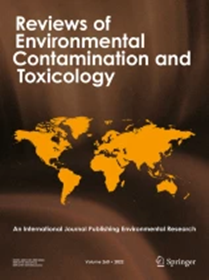Environmental Carriers for Metal Nanoparticles: Transport, Fate, and Eco-risks
IF 6.6
3区 环境科学与生态学
Q1 ENVIRONMENTAL SCIENCES
Reviews of environmental contamination and toxicology
Pub Date : 2023-09-12
DOI:10.1007/s44169-023-00046-w
引用次数: 0
Abstract
The occurrence of metal nanoparticles (MNPs) is an established environmental menace. After MNPs are released into the environment, they can interact with surrounding components and further be embedded within environmental substances, forming MNPs-carrier composites. Many studies have documented MNPs as individual particles. Yet, the specific impacts of environmental substances on the transport, fate, and eco-risks of MNPs-carrier composites have not been systematically analyzed. Here, we conducted a comprehensive review to illustrate the environmental carrier role for MNPs by different environmental substances and components, influencing their occurrence, transport route, transformation, and eco-effect, which calls for a reconsideration of the MNPs’ eco-/health-connectivity. Studies on MNPs’ environmental carrier in primary environmental domains reveal that in the atmosphere, MNPs-carrier composites are from nature-originated particulates followed by anthropogenic sources (e.g., traffic and industry exhausts); in the hydrosphere, various components (e.g., natural organic matter, extracellular polymeric substances, and proteins) can act as major carriers for MNPs; in the biosphere, microorganism and plant tissues can carry MNP-composites, which can be bioaccumulated and biomagnified through trophic transfer. Moreover, MNPs-carrier composites undergo distinct biogeochemical transformations in different environmental components, including aggregation, sedimentation, chemical transformation and dissolution, and the consequential biotransformation. Carriers’ impacts on MNPs’ environmental behavior manifested in changed bioavailability with widespread ecotoxicity via cellular uptake, oxidative stress and metal ions release, as well as in human health with adverse effects. Overall, this review can facilitate the understanding of MNPs-carrier composites’ origin, transformation, fate, and eco-/health risks in the environment, proposing future research needs.金属纳米颗粒的环境载体:运输、命运和生态风险
金属纳米颗粒(MNPs)的出现是一种公认的环境威胁。MNPs释放到环境中后,可与周围组分相互作用,并进一步嵌入环境物质中,形成MNPs-载体复合材料。许多研究已经将MNPs记录为单个粒子。然而,环境物质对mnps载体复合材料的迁移、命运和生态风险的具体影响尚未得到系统分析。本文通过对不同环境物质和成分对MNPs发生、迁移路径、转化和生态效应的影响,对MNPs的环境载体作用进行了综述,并提出了对MNPs生态/健康连通性的重新思考。对主要环境域MNPs环境载体的研究表明,在大气中,MNPs载体复合材料主要来自自然来源的颗粒物,其次是人为来源(如交通和工业废气);在水圈中,各种成分(如天然有机物、细胞外聚合物质和蛋白质)可以作为MNPs的主要载体;在生物圈中,微生物和植物组织可以携带mnp复合物,并通过营养转移进行生物积累和生物放大。此外,mnps -载体复合材料在不同的环境组分中经历了不同的生物地球化学转化,包括聚集、沉积、化学转化和溶解,以及随之而来的生物转化。载体对MNPs环境行为的影响表现为通过细胞摄取、氧化应激和金属离子释放改变生物利用度和广泛的生态毒性,并对人体健康产生不良影响。总的来说,本文综述有助于了解mnps载体复合材料的起源、转化、命运和环境中的生态/健康风险,并提出未来的研究需求。
本文章由计算机程序翻译,如有差异,请以英文原文为准。
求助全文
约1分钟内获得全文
求助全文
来源期刊
CiteScore
12.80
自引率
0.00%
发文量
11
审稿时长
>24 weeks
期刊介绍:
Reviews of Environmental Contamination and Toxicology publishes reviews pertaining to the sources, transport, fate and effects of contaminants in the environment. The journal provides a place for the publication of critical reviews of the current knowledge and understanding of environmental sciences in order to provide insight into contaminant pathways, fate and behavior in environmental compartments and the possible consequences of their presence, with multidisciplinary contributions from the fields of analytical chemistry, biochemistry, biology, ecology, molecular and cellular biology (in an environmental context), and human, wildlife and environmental toxicology.
•Standing on a 55+ year history of publishing environmental toxicology reviews
•Now publishing in journal format boasting rigorous review and expanded editorial board
•Publishing home for extensive environmental reviews dealing with sources, transport, fate and effect of contaminants
•Through Springer Compact agreements, authors from participating institutions can publish Open Choice at no cost to the authors

 求助内容:
求助内容: 应助结果提醒方式:
应助结果提醒方式:


